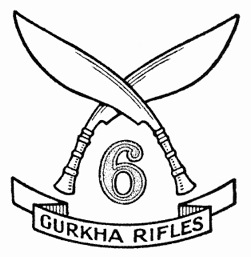The 6th Gurkha Rifles (now 6th Queen Elizabeth’s Own Gurkha Rifles) has its origins in India where, in 1817, unrest in the Cuttack district resulted in the formation of a unit of Indian natives, known as the Cuttack Legion, to maintain order in the area. The Regiment was later moved to North Bengal and renamed Assam Light Infantry. During the Indian Rebellion of 1857, the Regiment remained loyal to the British and was transferred from the East India Company to the British Indian Army.
In the course of its existence, the Regiment increasingly recruited Nepalese Gurkhas into its ranks. The Gurkhas were highly regarded by the British for their fearlessness and military skill – it was said that “if a man says he is not afraid of dying, he is either lying or is a Gurkha.” By 1886, the unit became a pure Gurkha Regiment and accordingly changed its title to the 42nd Regiment of Gurkha Light Infantry. Five years later the name was amended to the 42nd Gurkha Rifle Regiment of Bengal Infantry. Up to the start of the First World War the Regiment remained primarily in India, patrolling the north-east border of the country.In 1903, following a recast of all military units, the Regiment became known as the 6th Gurkha Rifles. A year later, its size was increased to two battalions. A third battalion was raised at the outbreak of the First World War but remained for the most part in India. The 1st Battalion was the first Gurkha unit to arrive at Gallipoli, landing at Cape Helles in early May. Their first major operation, which left 18 Gurkhas dead and 42 wounded, was the successful capture of a Turkish machine gun position on top of a 91-metre vertical slope which had defeated similar attempts made by the Royal Marine Light Infantry and the Royal Dublin Fusiliers. To commemorate the Regiment’s success, the area became known as Gurkha Bluff. In August 1915, the Battalion landed at Anzac Cove where it secured the crest of Sari Bair and held the position for three nights and three days until forced to withdraw in the face of massive Turkish counter-attacks. After Gallipoli, the Battalion served in Egypt and Mesopotamia.

